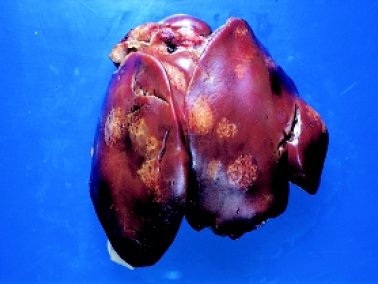Blackhead is caused by the amoeba-like parasite Histomonas meleagridis. The disease is a significant threat to commercial flocks globally. It affects various birds including game birds, peafowl, and gallinaceous birds. Domestic turkeys and peafowl can experience death rates as high as 80-100%. Chickens, particularly broiler breeder pullets, may suffer 10% mortality.
Blackhead can be passed from peafowl to peafowl and there is no highly effective treatment – prevention and quarantine if necessary are essential.
Signs and Symptoms
Birds with Blackhead disease are usually listless with drooping wings and unkempt feathers, and have yellow droppings. Young birds in particular become sick quickly and usually die within a few days of signs appearing.
Typically, an infected bird will have an inflamed necrotic liver and an ulcerated caeca.

Aetiology
“Heterakis gallinarum is a roundworm found in the caeca of domestic and wild birds worldwide. It is the commonest nematode parasite of poultry. While not pathogenic itself, it acts as a vector for the protozoa causing Blackhead. Chickens, known as the best hosts for Heterakis, likely serve as the source of contamination, and footwear the facilitator.
Initially it was thought that Blackhead only resulted from the ingestion of these roundworms. However, research later demonstrated direct transmission of Histomoniasis from infected to uninfected turkey poults without intermediaries. Here transmission likely occurred through cloacal drinking, involving the intake of liquid faeces. This discovery implies that separating healthy birds from sick ones can prevent the infection’s spread within the flock. This concept has proven successful in some instances, offering a practical approach to controlling Blackhead disease.
Prevention
Prevention of Blackhead in peafowl is by quarantine and the use of migration barriers. Avoiding contact with chickens or game birds not wormed regularly, preventing co-mingling of infected and uninfected birds, and good litter management are all important measures.
The protozoa causing Blackhead may remain infective in the soil for nearly three years. Therefore raise each new flock on new clean ground. Young turkeys should never be reared near older turkeys, or with chickens that may carry the infection.
Moving feeders, waterers, and roosts periodically will help prevent the local build-up of infective organisms,as will good sanitation and litter management.
Research into a vaccine is ongoing and may be available long term.
Treatment
When a peafowl flock member becomes infected, Blackhead spreads easily from bird to bird. Emetryl did have some effect previously but is unfortunately no longer available. The best current treatment for the disease in my experience is Metronidazole or Dimetridazole, but effects are variable. Other birds such as chickens will seem to respond initially, however this is probably due to treatment of secondary infections with bacteria. Frequent preventive use of wormers (Benzimidazole) remains the most effective defence.